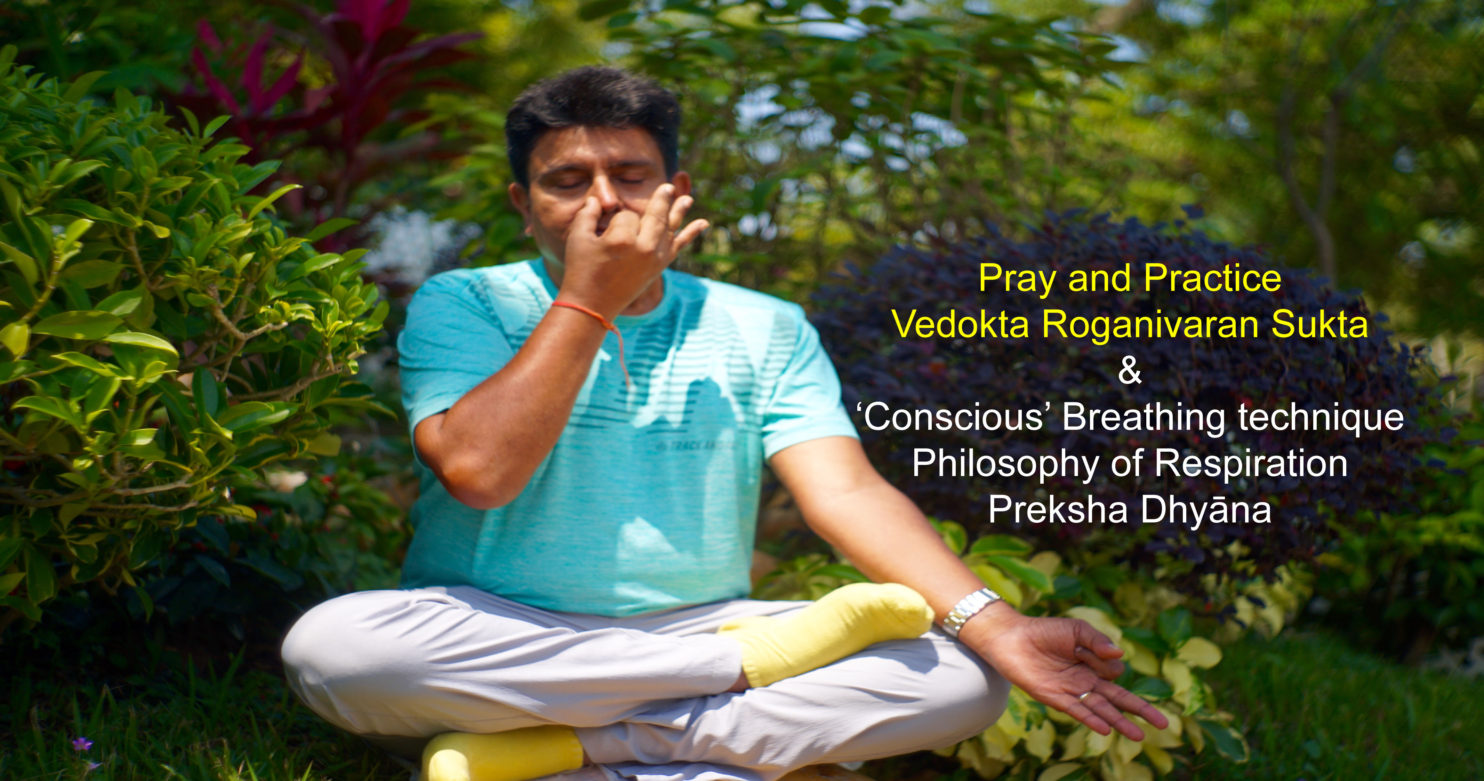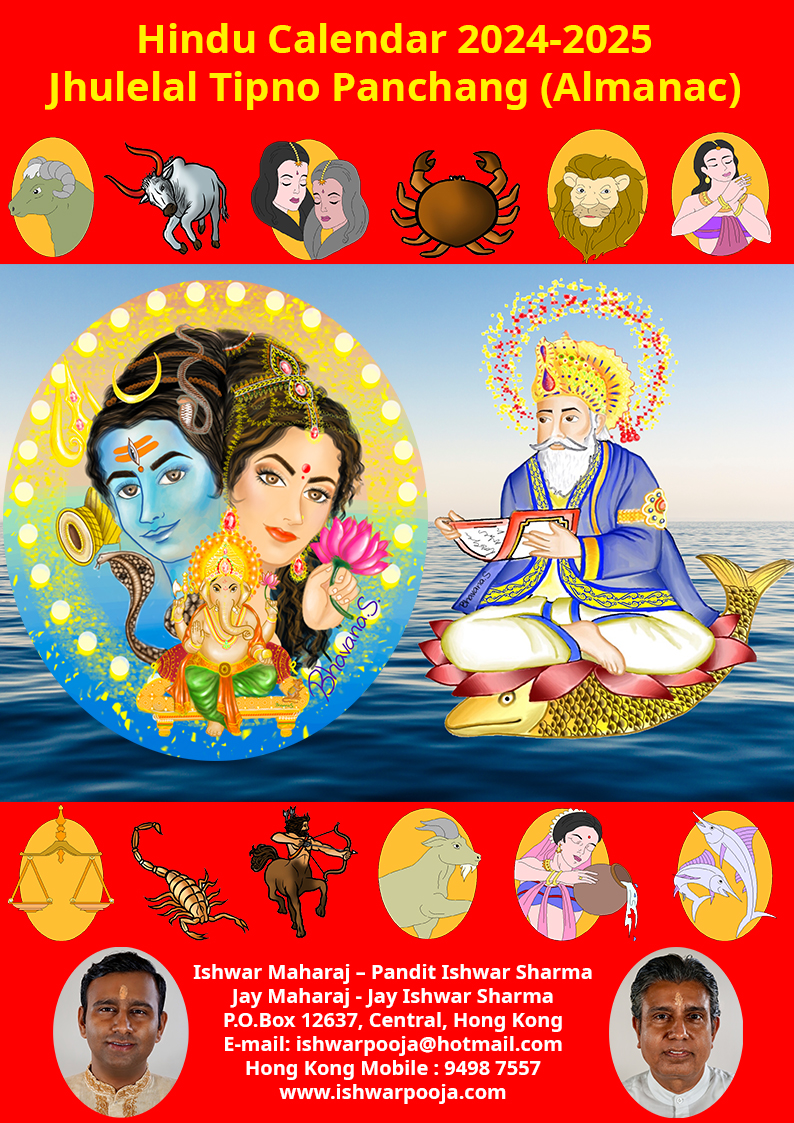वेदोक्त रोगनिवारण सूक्त
Pray and Practice
Vedokta Roganivaran Sukta
and
‘Conscious’ Breathing technique
Philosophy of Respiration
Preksha Dhyāna
प्राणायाम
Health is wealth!
Aarogya hi sampadaa!
Jaan Hai, to Jahaan Hai!
‘Jivo Jivasya Jivanam : Life lives on life.’
‘Jivannaro Bhadra-shataani Pashyet.’ PT.4 Sukti Sudha p. 296.
Meaning: ‘A man, only while living, can witnesss a hundred auspicious happenings!’
वेदोक्त–रोगनिवारणसूक्त
(ऋग्वेद एवम् अथर्ववेद से)
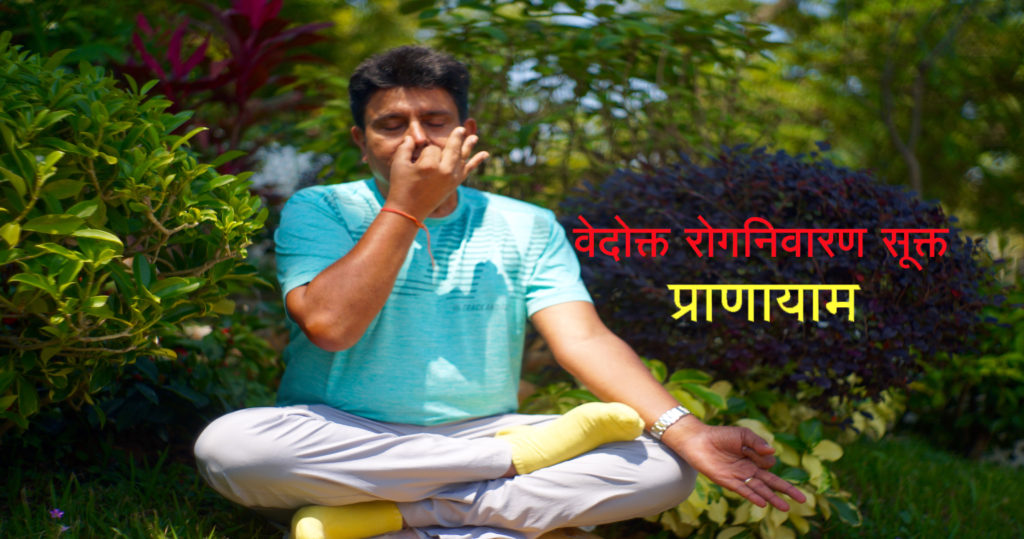
ॐ
उत देवा अवहितं देवा उन्नयथा पुनः ।
उतागश्र्चकुषं देवा देवा जीवयथा पुनः ॥ १ ॥
हे देवो ! हे देवो ! आप नीचे गिरे हुएको फिर निश्चयपूर्वक ऊपर उठाओ ।
हे देवो ! हे देवो ! और पाप करनेवाले को भी फिर जीवित करो ।
द्वाविमौ वातौ वात आ सिन्धोरा परावतः ।
दक्षं ते अन्य आवातु व्यन्यो वातु यद्रपः ॥ २ ॥
ये दो वायु हैं । समुद्र से आनेवाला वायु एक है और दूर भूमिपर से आनेवाला दूसरा वायु है ।
इसमें से एक वायु तेरे पास बल ले आवे और दूसरा वायु जो दोष हैं, उसे दूर करे ।
आ वात वाहि भेषजं वि वात वाहि यद्रपः ।
त्वं हि विश्र्वभेषज देवानां दूत ईयसे ॥ ३ ॥
हे वायु ! ओषधि यहाँ ले आ । हे वायु ! जो दोष है, वह दूर कर ।
हे सम्पूर्ण ओषधियों को साथ रखनेवाले वायु !
नि:सन्देह तू देवोंका दूत:-जैसा होकर चलता है, जाता है, बहता है ।
त्रायन्तामिमं देवास्त्रायन्तां मरुतां गणाः ।
त्रायन्तां विश्र्वा भूतानि यथायमरपा असत् ॥ ४ ॥
हे देवो ! इस रोगों से रक्षा करो । हे मरुतोंके** समूहों !
रक्षा करो ! जिससे यह रोगी रोग:-दोषरहित होवे ।
आ त्वागमं शंतातिभिरथो अरिष्टतातिभिः ।
दक्षं त उग्रमाभारिषं परा यक्ष्मं सुवामि ते ॥ ५ ॥
आपके पास शान्ति फैलानेवाले तथा अविनाशी करनेवाले साधनोंके साथ आया हूँ ।
तेरे लिये प्रचण्ड बल भर देता हूँ । तेरे रोगोंको दूर कर भगा देता हूँ ।
अयं मे हस्तो भगवानयं मे भगवत्तरः ।
अयं मे विश्वभेषजोऽयं शिवाभिमर्शनः * ॥ ६ ॥
मेरा यह हाथ भाग्यवान् है । मेरा यह हाथ अधिक भाग्यशाली है ।
मेरा यह हाथ सब औषधियोंसे युक्त है और यह मेरा हाथ शुभ-स्पर्श देनेवाला है ।
हस्ताभ्यां दशशाखाभ्यां जिह्वा वाचः पुरोगवी ।
अनामयिन्तुभ्यां हस्ताभ्यां ताभ्यां त्वाभि मृशामसि ॥ ७ ॥
दस शाखावाले दोनों हाथों के साथ वाणीको आगे प्रेरणा करनेवाली मेरी जीभ है ।
उन निरोग करनेवाले दोनों हाथों से तुझे हम स्पर्श करते हैं ।
॥ इति रोगनिवारण सूक्त ॥
– ॐ –
ऋग्वेद में ‘अयं मे हस्तो॰’ के स्थानपर यह दूसरा मन्त्र उल्लिखित है :-
*आप इद्वा उ भेषजीरापो अमीवचातनी: ।
आप: सर्वस्य भेषजीस्तास्ते कृण्वन्तु भेषजम् ॥
जल ही नि:संदेह ओषधि है । जल रोग दूर करनेवाला है ।
जल सब रोगोंकी ओषधि है । वह जल तेरे लिये ओषधि बनावे ।
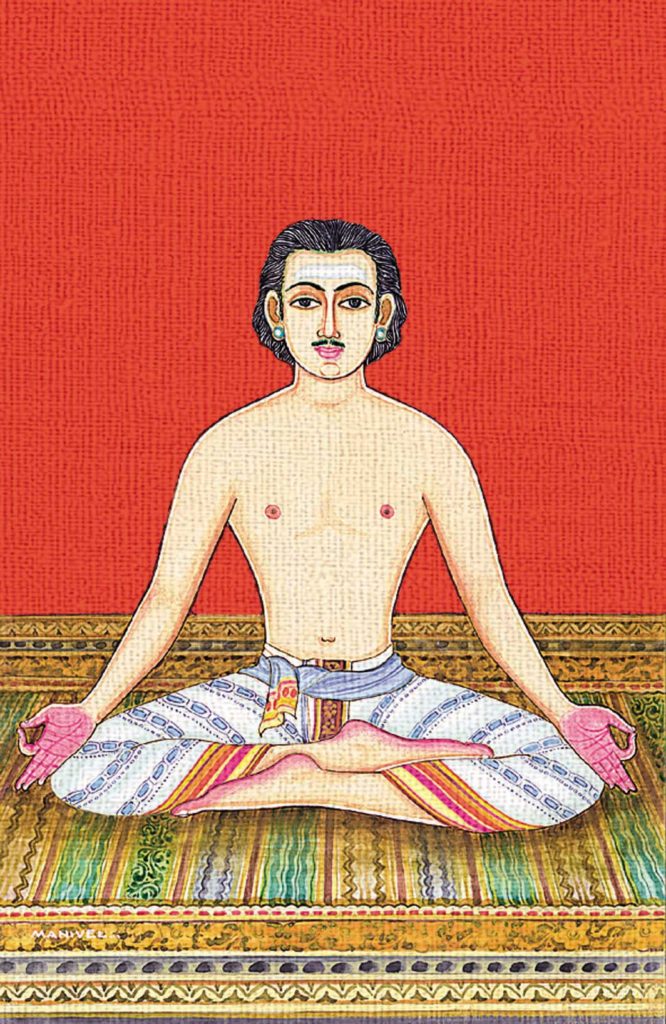
Vedokta Roganivaran Sukta
(Rig-Veda Tenth Mandal 137 Sukta & Atharva-ved)
Uta Devaa Avahitam Devaa Unnayathaa Punaha.
Utaagashchakrusham Devaa Devaa Jivayathaa Punaha. (1)
Dvaavimau Vaatau Vaata Aa Sindhoraa Paraavataha.
Daksham Te Anya Aavaatu Vyanyo Vaatu Yadrapaha. (2)
Aa Vaata Vaahi Bheshajam Vi Vaata Vaahi Yadrapaha.
Tvam Hi Vishvabheshaj Devaanaam Doota Iyase. (3)
Traayantaamimam Devaas-traayantaam Marutaam Ganaahaa.
Traayantaam Vishvaa Bhutaani Yathaayamarapaa Asat. (4)
Aa Tvaagamam Shamtaatibhiratho Arishtataatibhihi.
Daksham Te BhadramAbhArShaM Paraa Yakshmam Suvaami Te. (5)
Ayam Me Hasto Bhagwaanayam Me Bhagwattaraha.
Ayam Me Vishva-bhesjo-ayam Shivaabhimarshanaha*. (6)
Hastaabhyaam Dashashaakhaabhyaam Jihvaa Vaachaha Purogavii.
Anaamayintubhyaam Hastaabhyaam Taabhyaam Tvaabhi Mrishaamasi. (7)
Aap Edwaa Bheshajiraapo Amivachaatanihi,
Aapaha Sarvasya Bheshajistaastey Kirnavantu Bheshajam.
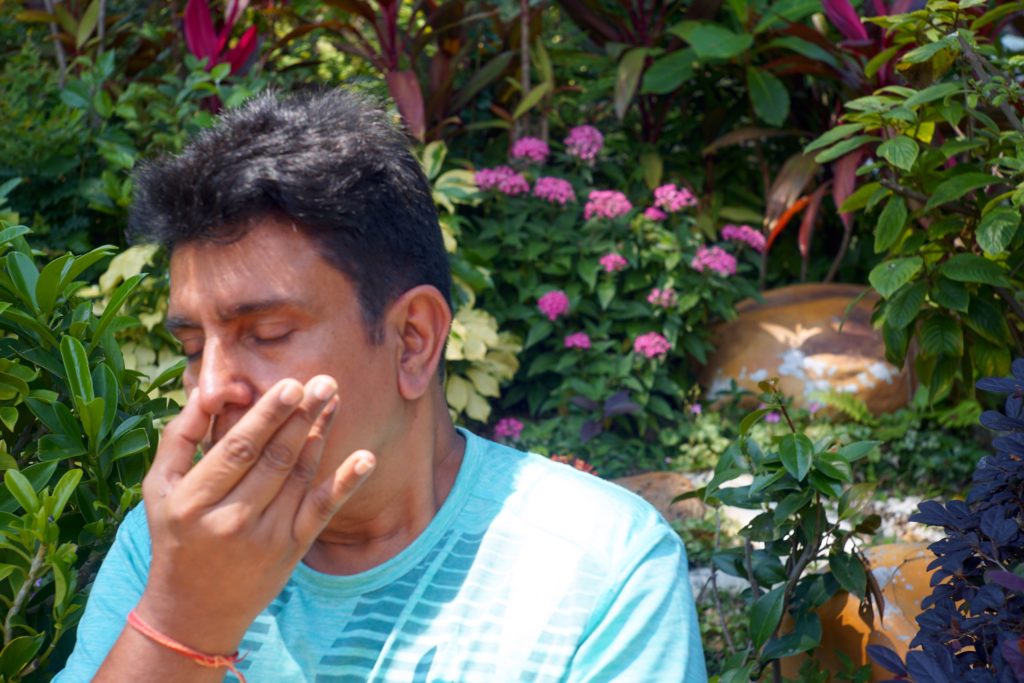
‘Conscious’ Breathing technique
Philosophy of Respiration
Preksha Dhyaana
The trio prana, pranavayu and pranayama are linked intimately with one another.
‘Regular practice of pranayama is an efficient means of improving the quality of respiration.
Pranayama – scientific complete breathing-starts with fuller utilization of
the vital capacity of the lungs by slow, silent and deep breathing’.
“The science of pranaayaamaa starts with the proper control of the diaphragm and the
respiratory muscles, which will bring the maximum degree of lung expansion in order to
absorb the greatest amount of the life-giving energy from the air”. P. 235.
It’s one of the most important practices in all forms of Yoga. (Pranayama or yogic breathing).
Modern science fully endorses the teachings of the ancient preceptors of yoga on this subject’.
‘Plants grow actively when they are properly watered, but shrink down if watering is
disrupted. Similarly, organs, tissues and cells remain active when supplied with oxygen and
become sluggish and die down in its absence’.
Respiration is Spiritual Energy
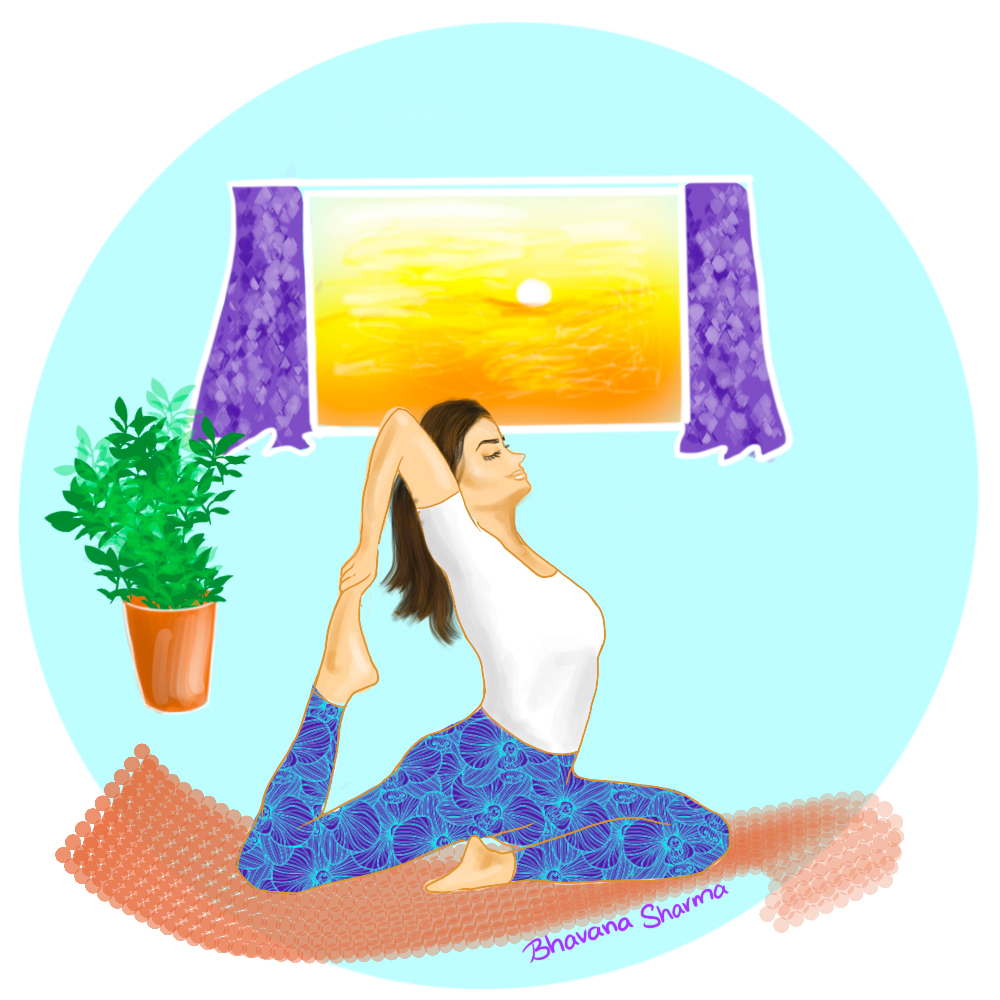
“This aphorism from the Jain canon Dasaveāliyam forms the basic principles of Preksha Dhyāna. Itmeans : “See you Thyself.” Perceive and realize the most subtle aspects of consciousness by your conscious mind. Body and soul, though transcendentally two different existents, are united to form a single entity – a living organism. Breathing and life are practically synonymous. To breathe is to live and to live is to breathe. Breath is intimately connected with the body and mind. It is the bridge permitting access to nervous system, mind and vital energy (praana-sakti). Breath, body and mind all are energized by the vital energy. Vital energy itself is activated by a suble body (taijasa sarira) and the latter is energized by the most subtle body (karma sarira). At the ultimate end of the chain is soul or consciousness. And hence perception of the vibrations of breath, body, vital energy and karmic energy is equivalent to cognition of SELF – the conscious energy which animates all other energies including vital energy.
Technique of Preksha Dhyana is based on the concentrated perception of breathing, body, psychic centres and thoughts etc.”
Breath is intimately associated with prana, which is the kinetic form of paryaapti, i.e. the potential vital energy. This is inherent in the basic life-substances formed at the very first moment of conception in the womb. 1 It is continuously nourished by breath throughout the life. It’s well known that when we breathe in, we inhale oxygen which is essential for life. Oxygen is delivered to each cell of the body to generate vital energy. Thus, one needs nourishment supplied by prana. To breathe is to live and to keep alive, one must inhale and assimilate prana without break. Inhialation and assimilation are virtually non-stop throughout life. Thus, in the ultimate, breath is the only efficient means of providing prana which is essential for generating vital energy”.
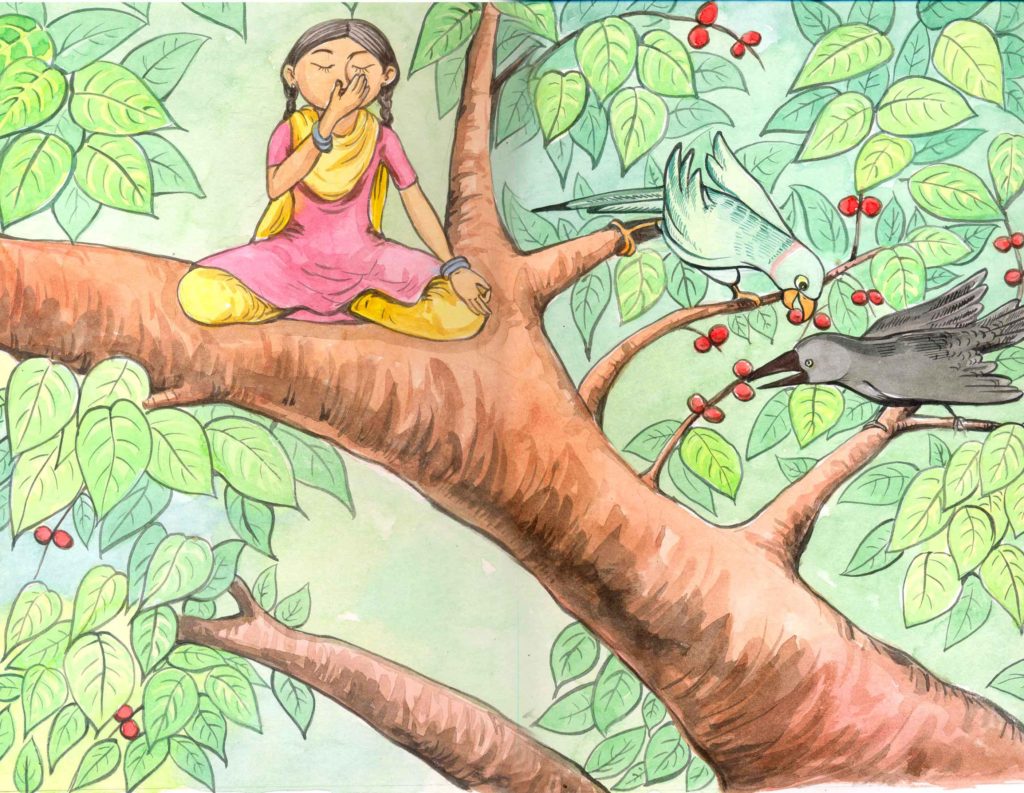
What is breathing? What is pranamaya-kosha?
and how is the process of breathing, healthy breathing importance?
Meaning of Breathing, Process of Breathing & importance of healthy conscious breathing
‘To breathe means to live and to live means to breathe. Every living thing depends upon breathing and cessation of breathing is cessation of life itself. From the first cry of the infant to the last gasp of a dying man there is nothing but a series of breaths. Yogis count life not by number of years but number of breaths. We constantly drain out life force or pranic energy by our thinking, willing, acting, etc. Every thought, every act of will, or motion of muscles uses up this life force and in consequence constant replenishing is necessary, which is possible mainly through breathing alone. Just as oxygen is carried through the blood stream to all parts of the body, building up and replenishing, so is the prana carried to all parts of the nervous system. If we know that Yogis get most of their energy from the air, then the importance of proper breathing is readily understood. Whoever practices breathing regularly and systematically can feel in his own body this great effect of absorption of prana. Svaasa (Breathing) consists of two stages, ‘breathing in’ or inhaling and ‘breathing out’ or exhaling. Pranamaya Kosha: “The layer where bio-energy flows to sustain life”. (It’s one of the Panchkosha (5 layer – sheaths) of the human existence p. 160). ‘The Pranamaya Kosha contains the Physical Prana. It moves the Karanas into action. It causes hunger and thirst. Hunger and thirst are sensations belonging to the Praanamaya Kosha and not to the Atman.” The yoga of wisdom (P. 341).
“Fresh air inhaled in the lungs contains oxygen which enters the blood-stream via the cappilaries which surround the walls of the alveoli. Haemoglobin, a constituent of the red blood cells, is a chemical compound with strong affinity for oxygen. The process of combination of haemoglobin and oxygen takes place in the lungs. The heart pumps oxygen- bearing haemoglobin to all parts of the body and delivers oxygen to the cells in the active tissues. Cells use the oxygen to produce energy. Carbon-dioxide, which is a bye-product of energy-production, is carried away by the blood to the lungs for exhalation. Thus, breathing is a great vital source of energy. The animation of the entire organism, that is each and every activity of life, needs energy. Functioning of sense-organs, brain, intellect, speech and bodily movements are all powered by energy. Flow of bio-energy is the source of power for all activities. Only the vital bio-energy is capable of animating sense-organs, brain and body which would remain inanimate otherwise.”
“Controlled and conscious breathing, as in svasa-preksa (perception of breath) is the source of still greater power. Most demonstrations of strength by feats such as driving of a car or a truck over one’s chest are nothing but canalized and concentrated bio-energy produced by properly-controlled conscious breathing. The deeper and slower is the breathing, the greater is the production and availability of energy. The soul, the conscious element of the psychic existence, possesses infinite vitality and power. Since breath is the dynamic manifestation of
this infinite potential power, conscious breathing can work and demonstrate miraculous feats.
The greater the supply of oxygen, the stronger is the vitality. With oxygen-deficiency, the vitality will sag down. The physiological reason for this is : Blood from the tissues with a high carbon-dioxide content carried by veins enters the right chamber of the heart. At the same time oxygenated blood from the lungs fills up the left chamber. As the heart-walls contract, the pressure inside the chambers increases and the blood is forced out from both the chambers. The impure blood from the right rushes to the lungs and the oxygenated blood from the left is driven into the aorta, from where it is distributed throughout the body through the arterial net-work. In the lungs, the load of carbon-dioxide is given up to the alveoli and oxygen combines with the haemoglobin. From this, it is obvious that proper oxygenation of blood depends upon the adequate supply of oxygen and the exchange of gases in the alveoli of the lungs”.
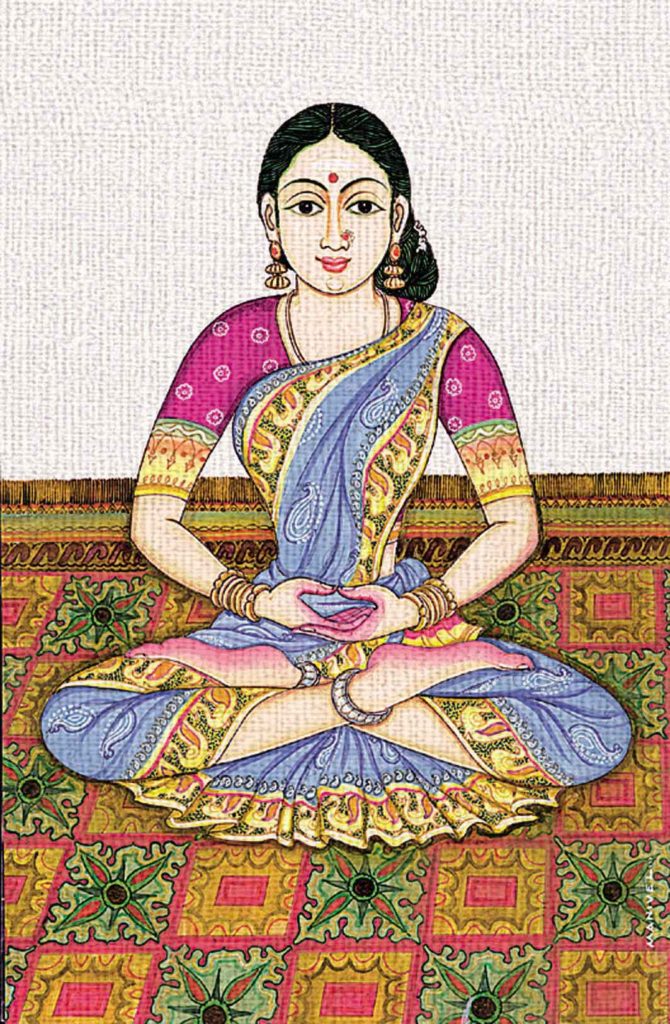
“Yogic treatises on breathing customarily recite some obvious facts:
- For human beings, without breath there is no life. Other animals also must breathe to live, and oxygen intake in some form is necessary for plant life down to its lowest forms.
- From birth to death, one must breathe. The independent life of a newborn child begins with his first gasp; it is unsage to sever his umbical cord and detach him from the oxygen supplied by his/her mother’s blood until he/she can breathe for himself/herself. Life is “an uninterrupted series of breaths” (Alain, Yoga for Perfect Health page 57). And after his last gasp, a man soon dies.
- “Man may go without food for a few months and without water for a few days, but without air he cannot exist for a few minutes” (N. V. Gunaji, Scientific and Efficient Breathing, page 1).
- All other functions of the body and mind depend upon breathing.”
“Everyone knows how to breathe. Breathing takes place automatically, spontaneously, naturally. So it seems foolish to think that one can be told how to breathe. Yet, one’s breathing naturally becomes modified and restricted in various ways, not just momentarily, but habitually. We develop unhealthy habits unawares. Not only do we drift into slouched positions with diminished lung capacities and shortened breaths as individuals, but we live in social conditions (in school, factory, home, office and movies) which normally induce sluggish tendencies in our systems.”
Which are Pancha Praana (5 five Praanaas) and Pancha Vaayu?
The pancha-vayu, pancha prana five praana are :
- Prana
- Apana Prana
- Samana Prana
- Udana Prana
- Vyana Prana.
Everyone of these five pranas is governed by five vayus or nerve impulses. These five vayus are:
- Prana vayu
- Apana vayu
- Udana vayu
- Vyana vayu
- Samana vayu
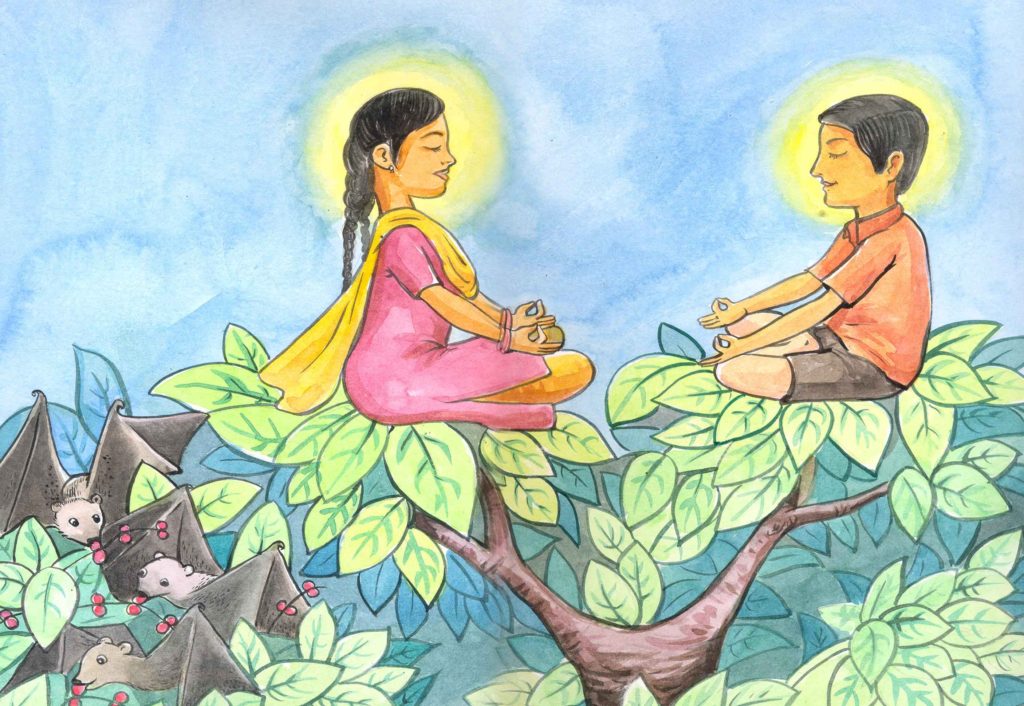
‘According to the Yoga philosophy, all visible and invisible happenings in the universe and in the body are the functions of one prana, which manifests in various forms. The activities of the human body automatically come under the control of prana and this cosmic prana as it functions in the body is named pancha pranas or five vital forces, according to the nature and function it performs.
Thes five pranas function through the five subsidiary nerve centers in the brain and spinal cord.
In addition to the five principal pranas, there are five more upa-prana or five minor vital
forces.’ (P. 232, 233 of Yoga : Pranayama or yogic breathing).
– Om –
Yogavashishtha:
“Sree Raamaa said:
Praanaadinaam Pari-spando Vaayunaam Ropyatey Kathama.
“How is the movement of vital energies (or vital ‘airs’) like Prana controlled?” (47)
Vasishtha said:
Shaastra-sajjana-samparka-vairaagya-abhyaas-yogataha. (47)
Eka-tatva-ghana-abhyaasaat Praana-spando Nirudhyatey.
Avaasanaat Madhyo-dhyaanaat A-sams-prashta-vikalptaha. (48)
Puurkaadhya-nilaayaamaat Omkaar-uchaarena vaa.
Guruktaanya-kramaat vaapi Praana-spando Niruddhyate. (49)
Abhyaasen Pari-spendey Praanaanaam Khayamaagatey.
Manaha Prash-mama-ayaati Nirvaanam Avashishyatey. (50).
50.When the movement of the vital airs (or bio-energies) has come to its end by practice, the mind attains to calmness and Nirvaana (or liberation from matter and mind and reunion with the Supreme Spirits) is left behind.”
– Om –
 Chhando-Darsana: Commentary – Summary Translation
Chhando-Darsana: Commentary – Summary Translation
“Indra and Vaayu together rule mid-air. In that middle region where the Earth and Heaven
meet, the son Bhagavan Rudra, Marut (Vayu)** blows and animates this inanimate world. It
is He that animates all beings dwelling therein with His animating capacity. He is an all-
pervader and father of Maruts, as He begets and protects them. He is Rudra, the lord of mid-
air and in him the universal life-force has its home. P.49.
It is certainly not possible to see him. So he is invisible because he has no form. Cf. “One can
observe his going, but not his form.” (Rigveda I-164-44) and “One can hear him sound but
not see his from.” (Rg. X-168-43).
Again, Yaaska in his Nirukta (12-27-1) says:- “The Madhyama has no form. This whole
universe and this body were inactive without him and He made them active and beautiful. Cf.
The Brhadaaranyaka Upanishad elaborates the same…,
“Gautama, Vayu is the thread, and by him are all creatures held together.” (Br. Up. III-8-9).
Therefore, Vayu, though formless, becomes visible when he combines with Indra who is all
activity; he is made visible by being active. Without Vayu, this body etc. goes out of
existence. Cf. “Life continues in the body only so long as the Vāyu is in it,” says the
Brhadāranyaka Upanishad. It is further explained in the mantra : “Oh Vayu, be visible” (Rg.
I-2-1). ‘Darsata is Darsaniya’ is what Yaska (Yāska 10-2-1) says that Vayu is the activity of
Indra, the Purusha par excellence, as denoted by mantra, “Vāyu was born of His Prāna.”
(Rigved X-90-13). Vayu is the lord of mid-air. He becomes associated with Indra, when he
exhibits his might. Cf. “Indra lives in my might” – (Taitti. Yaju.). So, Vaayu is the best light
which illumines the whole universe. He is the light par excellence which lightens up all and
everything. He is Vaayu, in association with Indra.” P. 47.
– Om –
Shri Bhagwat Geeta:
‘Apaane juhvati praane paanam tathaapare,
Praanaapaanagati ruddhvaa praanaayaama-parryanaha;
Apare niyataahaaraaha praanaan praanesu juhvati.’
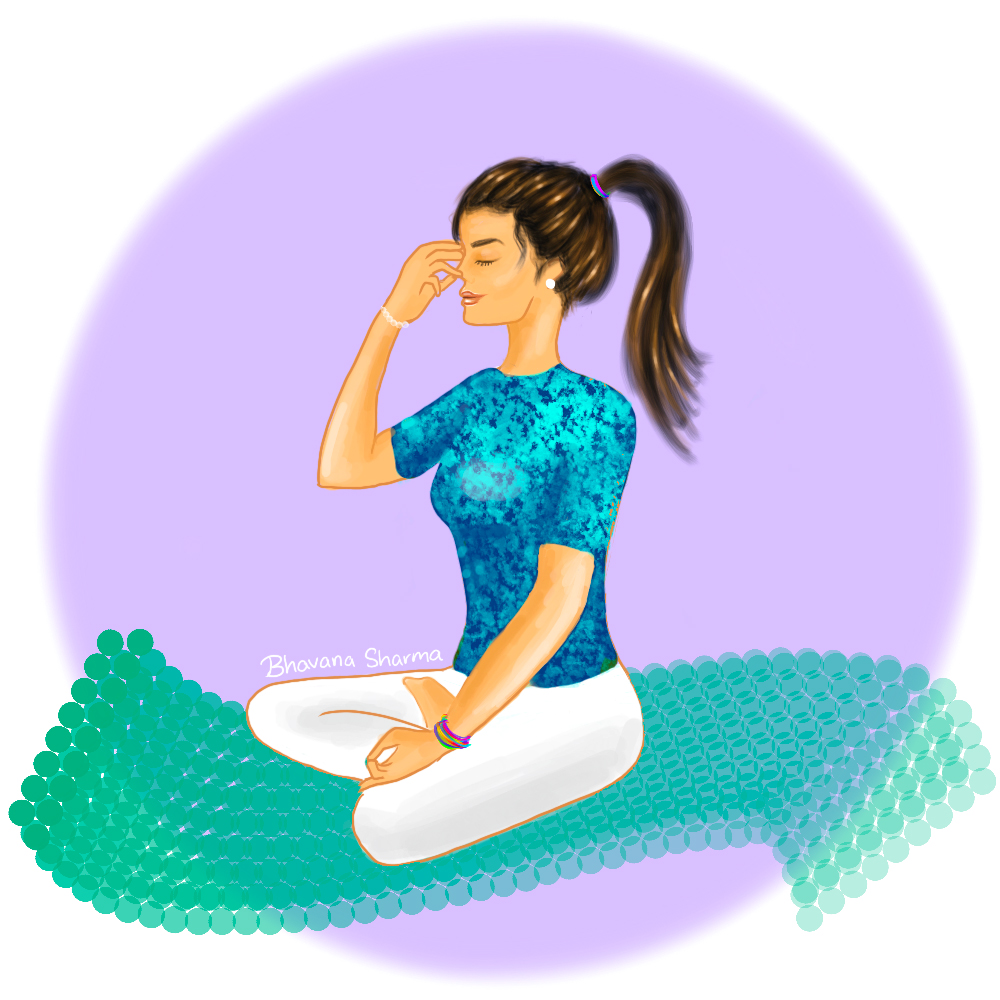 “On Pranayamas: (10) It would be wrong to assume that all pranayamas could be practiced
“On Pranayamas: (10) It would be wrong to assume that all pranayamas could be practiced
with safety even by the young. Initially, it would be wise to begin with simple ones which
would help to control the respiration or the use of the respiratory organ, e.g., the simple forms
of sunyaka, puraka, kumbhaka and rechaka. Only later on could these different practices be
combined in sequence.” P. 288.
Let us pray to Lord for everyone’s good health and longevity!
Let us practice to have healthy conscious breathing and active fit fresh body, mind!
Let us be physically, mentally and spiritually elevate ourself!
Cautionary Note: Prāna inhaling and exhaling proper (different prānāyāmā) techniques to be learned and observed under the guidance of its subject masters. Compiler has compiled the article and has provided it in the good faith. No responsibility however can be ascribed to the compiler regarding its any contents! Jhulelal Tipno Panchang (Almanac) / Hindu Calendar, Parva-Patrikā is given in good faith. No responsibility however can be ascribed to the compiler regarding contents of this Almanac. Compiler.
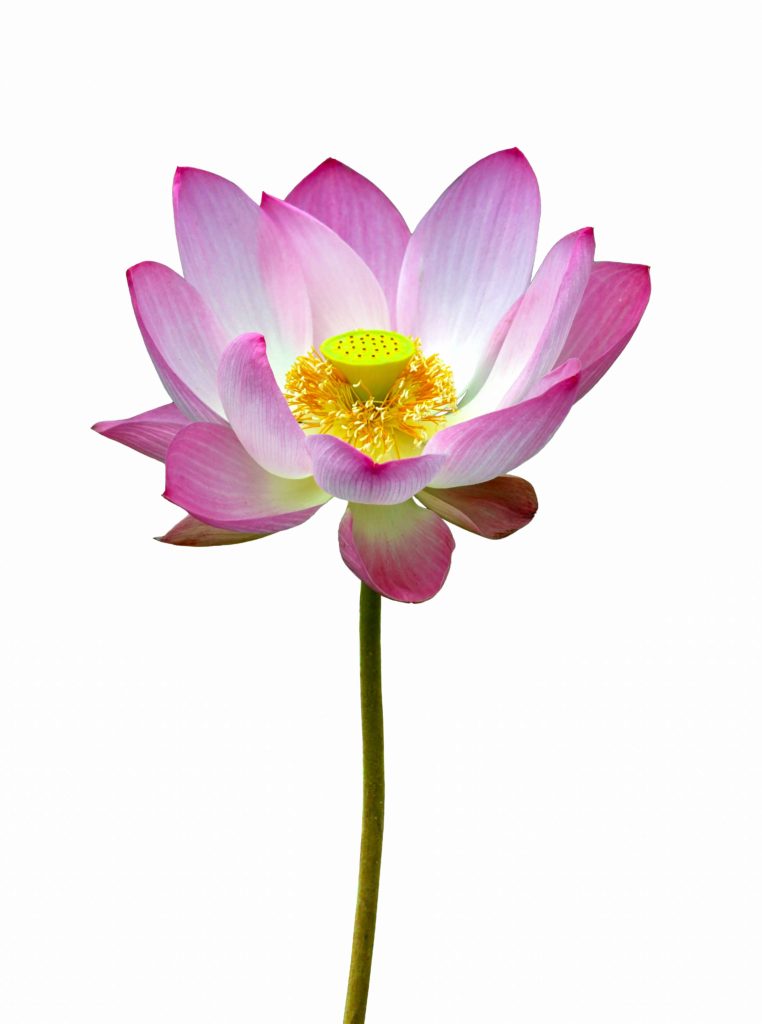 Acknowledgement:
Acknowledgement:
Mata Pujya Pushpadevi Pita Parsram and Mata Pujya Satidevi Ramchand K. Sharma, Moudgalya Gatra. Smt. Satidevi used to do one of yoga posture. Pujya Professor Shri Ramchandji, he himself used to do pranayama and his friend Sant Shri Vishnudasji’s Ashram place I used to learn technique of yoga, pranayama and self-defence, and also satsang and havan pooja prayers. Thanks to Gurus: Shri B. M. Bharadwaj-ji, Pujya Shri Ramchand A. Shandilyaji, Pujya Shri Narayandutta Shastriji; Diksha: Pujya Shri Lachhmandas K. Sharma, Pujya Shri Gagiram R. Bharadwaj (Sharma); Pujya Shri Gautamji, Pujya Shri Katyayaniduttji, Pujya Shri Kishinchand Jetley-ji, Pujya Shri Satishji Sharma; College Principal Shri Talrejaji and professors: Pujya Shri Madhu Jaisinghani – daily yoga practicing one and diet conscious (he after his retirement, I used for early running, I used to see him early morning doing seva sometimes at Sai Teonram Yoga Ashram – Shantiprakash Yoga Ashram or at Netaji Book Library, Shri Dayal Ashaji, Shri Narayananji, Shri Jadavji, Shri Choudhariji, Shri Patelji, Smt. Lucas-ji, Shri Shivo Bodhaniji, Smt. Meena Roopchandani, Smt. Niramala G. Roopani, Shri Dodaniji and Shri Jagdish Lachhani; School Teachers Shri Jounkaniji, Shri Kanahaiyalal Katariaji, Shri Prakash Master, Smt. Devaji, Pujya Shri Arthmalji, Pujya Shri Vishnuji; Shri Chandrasenji, Shri Jani Master, Pujya Shri Golani-ji, Shri Verhomal-ji, Shri Jashanji; Shri, Purani-ji, Smt. Gauriji, Smt. Devaji, Prin. Smt. Ambvaniji. Due thanks to Veda, Vedanta and Upanishad, Brhadaaranyaka Upanishad . Rig-Ved, Atharva-Ved, Sri Rama, Sri Rudram, Rudra-Rudrani, Indra, Chandra-dev (Chandrama), Sapta Rushi (Rishi Shantaati, Rishi Vishwamitra, Rishi Gautam, Rishi Gautam, Rishi Bhardvaj, Rishi Kashyap, Rishi Atri, Rishi Vishvamitra, Rishi Jamdagni), Bhirgu – Bhrgu, Narad, Sanak, Sankaadik, Sanatan, Santakumar, Maandavya, Markandeya and Maudalya (Mudgal), Atreya, Angira, Bharadwaj, Shandilya, Jetley, Kashyap, Kaushal, Kaundilya, Parashar, Vishwamitra, Rishabhdev, Durvasa-rishi, Sage Patanjali Maharshi, Bhaargava, Taitriya Upanishad, Vishnu-Gupta Chaanakya. Religious healing in the Vedas (Ved: Vedo Narayanaha Saakshaat, Vaidokta Roga Nivaarana Sukta p. 452) Vedic Rognivaarana Sukta, Mrityunjayeshwar Gaurisham Shri Mahadeva Shiva and Vishve-Deva. ‘Science of Living series – IV Preksha Dhyana : Perception of Breathing by Yuvacharya Mahaprajna, translated by Muni Mahendra Kumar and Jethalal S. Zaveri, Tulsi Adhyatma Nidam, Jain vishva Bharati, Ladnun-341306 (Rajasthan) second edition 1985 page numbers 9, 10, 11 and 12. Nitya-karma trikaal Sandhyaa prayers & praanaayaama. Sindhi Brahmans, Saraswat Brahmans, Kashmiri Brahmans, Pushkarna Brahmans, Sanskritam English dictionary of Apteji, Matsya Purana. Shri Mritasanjeevani Stotram Thanks to Prabhu Naamouchaaranam Mahima Stotram Prayers to Dhanwantari for eradication of diseases Praarthana Sangrahaha. Dr. Phulgenda Sinha Yogic Cure for common diseases p. no. 91, Immortality and Freedom p. 56; Yoga for business executives Stanley Paul, London, Archie J. Bahm chapter III p. nos. 94, 95 and 96. Practice of Yoga by Sri Swami Sivananda published by Jnan Yagna Prasad, The Divine Life Society, P. O. Sivanandanagar, Dt. Tehri-Garhwal, U. P., Himalayas, India page 475. Geeta Gorakhpur Press, Kalyan anka, Vedanga edition. Special thanks to Swami Saradanandaji who visited at the Temple, Hong Kong. That time my services being Priest at The Hindu temple situated at 1B Wong Nei Chung Road, Happy Valley, Hong Kong. Respected Swami Saradanandaji send photos to Priest Ishwar Sharma, Hong Kong and a handwritten letter too. And also a Yoga book of Swami Vishnu-devananda. The Complete illustrated book of Yoga. This yoga literature of Swami Vishnu-devananda. From the said yoga subject p. numbers 228, 232, 233 and 235 are compiled herein in this article related to prana, prayama, pranavayu. The Essence of YOGAVAASISHTHA compiled by Sri Jnanananda Bharati translated by Samvid, Samata Books, Madras p. 177, 178 and 232. Chhando-Darsana by Rshi Devarata with a commentary by Kavyakantha Ganapatimuni (Printed by B. G. Guttal, B.A., L.L.B. at the Samyukta Karnataka Press, Koppikar Road, Hubli and Published by S. Ramakrishnan, Executive Secretary, Bharatiya Vidya Bhavan, Chowpatty, Bombay) page number 26, 27, 47, 49, 51 and 54. Pujya Shri Maniyarji who used to teach pranayama at temple; Smt. Sangeeta Ahuja used to teach yog pranayama; and thanks also to Smt. Seema R. Hiranandani, Pujya Shri Manu Makhija of Art of Living for arranging yoga pranayama knowledge serving when I was priest in April 2001 at the Hindu temple run by the Hindu Asssociation, Hong Kong. Thanks to Smt. Kavita Khosa Ji, Shri Jay Vani Ji, Gayatri Chellaram Ji and Yograj Ji for yoga. Pranah p.295 (life-breath, life, vitality, energy, vigour) P. 296, XV, SRM Subhaasitaratnahandamanjusaa, Sukti Sudha compiled by Dr. A. Ramaswamy Iyengar, Dr. B. S. Ramakrishna Rao, translators and editors Dr. C. N. Ratnam, Brni. Vividisha Chaitanya – Chinmaya International Foundation, Veliyanad, Ernakulam, Kerala, India. Rudra-Ashtaadhyaayi, Shukla Yajurveda, Krishna Yajurveda, Rudram, Garur purana, Shrimad Bhagwatam, Srimad Bhagwat Geeta, Yoga Sutra. Shri Ramdev babaji. Thanks to Ashtaang-yoga, Sri Krishna Geeta, Vaishnava Sampradaaya, Garga Samhita C.10, C61, v.23-26; Sri Madhava Acharya (Madhvacaryaji), Sri Sridhara Swamiji – Vishnu Swamiji, Sri Ramanuja Acharyaji, Sri Kesava Kashmiriji; Yagyavalka. Yoga Course for All by Yogacharya Hansraj Yadav of Bharatiya Vidya Bhavan, Bombay book dedicated to great Gurudev Shri Yogendraji Founder and President of The Yoga Institute, Santa Cruz page 288. The Yoga Institute Estd. 1918, Shri Yogendra Marg, Prabhat Colony, Santacruz East, Mumbai, India thanks to Shri Yogendraji and Dr. Hansaji – Smt. Hansaji Jayadeva Yogendra. Also special thanks to Bhavana Sharma. Yoga and Pranayama breathing exercise images by Bhavana; Jay Sharma’s manifold efforts and dedication related to this topic is being appreciated; and Pooja Sharma’s help on the subject matter.

Om Pranaya Namaha!
Om Vaayave Namaha!
Om Indraaya Namaha!
Om Rudraaya Namaha!
Om Rudraaniyai Namaha!
Om Prana Shaktayai Namaha!
Om Maruta Devaaya Namaha!
Om Veda-Devataaya Namaha!
Om Praana Purushottamaaya Namaha!
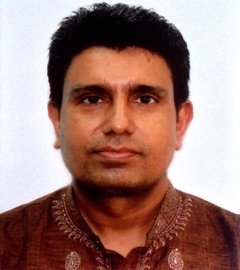
Ishwar Maharaj – Pandit Ishwar Sharma
Hong Kong Address : P.O.Box 12637, Central, Hong Kong
E-mail: ishwarpooja@hotmail.com
Hong Kong Mobile : 9498 7557
Hindu Community : Ceremonies, rites, and rituals are performed by Ishwar Maharaj – Pandit as and when required for those devotees in need for different poojas and prayers.
